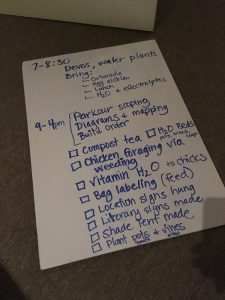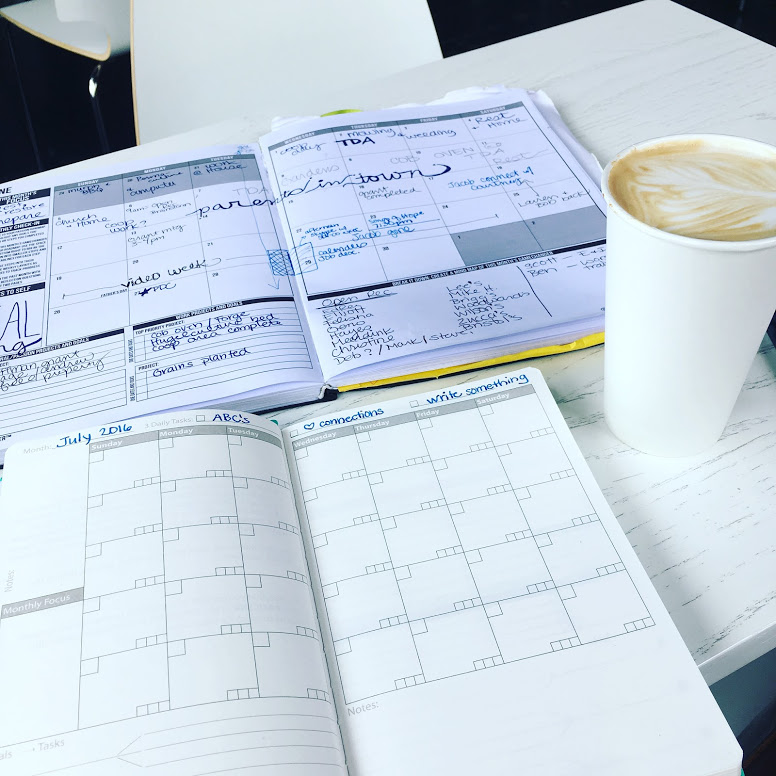As a type-A, leadership driven, slightly OCD personality, I know what it is like to get stuck in the planning phase of the building process. This brain freeze in the midst of a project is often referred to as planning paralysis. Overcoming planning paralysis is something that every good permaculturist struggles with at some point in time. From the very beginning of my permaculture journey, PDC leader, Geoff Lawton taught me that, “for every hour of work on a new project, you should have 10 hours of planning and observation.” At first, I thought, “NO WAY!” After all, I am a doer, a mover, and a shaker… not a philosopher. However, after realizing just how easy it is to walk around a property and get lost in your thoughts, or how fast time flies when you go out to the chicken coop “for a minute”…I quickly found the wisdom in his words.

One of my favorite ways of thinking through a new process or idea is by using a white board. I have one in my office, another two 8′ wide ones in the meeting room, and a portable one in my shed. Wait… I also have one portable one in my car and another one at home in the front closet incase an idea hits me in the evening. Sure, I use a whiteboard app on my iPhone, but honestly I prefer the size and functionality of using the markers.
How Do We Overcome Planning Paralysis?
In the past, when finishing an idea, I would let the board sit and sometimes erase it without following through on any of the components. The nagging fear in the back of my head has always been, “What if I forget something and mess it up? Maybe it’s better to wait until I have the perfect plan before starting anything.” Regardless of how much planning I do though – I will forget something and will find things I want to improve upon. Period. No plan is ever going to be perfect and no prototype is going to be the end-all-be-all. So, how do we then get out of the project planning phase and start overcoming planning paralysis?

Step 1 – Think with Strategy
Embrace the inner planning addict and let yourself have whiteboard time. Think, dream, and go big! Look for problematic areas and potential hang-ups. Examine the possible fruitfulness of the project and who you might include on your project dream team. Draw pictures, diagrams, make lists, and color code with 11 different colors of markers. GO FOR IT! Tweak one part of your process though, and add a column in your brainstorming for “Steps to Get Started”. The addition of this simple column in your planning will help you formulate the initial strategies for moving forward. Sure, the idea might fail, but at least you will know how to get moving.
Step 2 – Bring Someone Along with You
Even if you never want to pursue the idea, take someone else along with you for the ride – a student, intern, family member, friend, or co-worker. It is always good to have an extra eye on a project, but it is even more beneficial to have someone who can see things differently than you. Don’t bring someone with you who will agree with everything you say. Remember, you want to examine a full-spectrum. At the end of the brainstorming session, maybe you decide the project is not for you, but it’s possible that the person thinking along with you will want to take it on (or know someone who could). Fruitful conversations deserve their seeds to be planted.
Step 3 – Take a Picture of Your Brainstorming
Do not erase the board and walk away! Take a picture of your work to capture it “as is”. This visual can often be helpful to look back on, especially if there are images or diagrams. Plus, it is fun to look back on concept drawings from previous projects after a few years. Trust me, you can learn a lot from your own drawings and note-taking.
Step 4 – Type it Out
The last two steps are the most important in overcoming planning paralysis. After you have taken the picture of your brainstorming time, type it out. This simple step makes it searchable on your computer, easy to send to others, and helps make the process more streamlined. Often times when white boarding, we think conceptually. Something happens when we start typing and our brain begins to make things more linear. A natural process begins to develop and clear steps begin to form. The fact is, the pictures and images of the white boards often get lost in our photo albums of 400,000 other pictures of kids, trees, and mushrooms. However, making a digital file folder to organize your dreaming can give you the ability to go back and search them later.
 Step 5 – Take Actionable Step Toward the Goal
Step 5 – Take Actionable Step Toward the Goal
The last step is the most important in the process of overcoming planning paralysis. Take a practical and actionable step. It doesn’t have to be huge or involve a bunch of money. Your step might simply be to share the idea with another person. Projects that involve people get traction. Remember, every good idea is like a seed that deserves a chance to be planted. Who knows what fruit might come of your actions, but if you never try – you will never find out.
Let’s start planning and see what happens! For more information on Healthy Building, click here.

